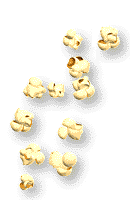|

A list of varying topics you may want to do your Science Fair Project
on.

 | Diaper Absorption - If you know several people with infants that
use different brands of diapers, you will find it inexpensive to do this project.
Ask the people if you can have a diaper for your project. Try to get at least 5 of them.
Make sure they range from a big brand name to generic. Make sure they are all close to the
same pound weight, so this doesn't affect your results.
Put water in some kind of measuring container. Pour the water slowly into the diaper until
it cannot hold anymore and just begins to spill out. Measure how much water the diaper
held. Keep a record of each brand of diaper and how much water it held.
For further investigation, do a comparative cost per diaper (ask the people how many
diapers came in the package and how much it cost) and how absorbent each one is. Which is
the best buy for the money?

|

 | Popcorn - With the regular type of popcorn (not microwave), count
out the same amount of kernels for at least 5 different brands. Using the same temperature
of heat, the same amount of oil, and the same amount of time, pop the corn on the stove.
Count how many unpopped kernels are left in each brand after cooling. Which brand popped
the most kernels? Which brand popped up the fluffiest?

|

 | Testing the pH of Water - Using an aquarium test kit from the pet
store, you can measure the pH (and hardness) of water. Try to get tap water from different
cities. If you are unable to do this, try testing different bottled water. You may even
want to consider testing the water of rivers, streams, lakes, ponds, and rain water.
Some test kits will also measure nitrate and ammonia in water. These indicate possible
pollution.

|

 | Magnetic Compass & True North - Does the needle of a magnetic
compass point exactly north?
Take a compass outdoors in a place far from a building and from iron objects. Mark on the
ground the direction in which the dark end of the needle points when it comes to rest. Now
find the direction of true north at that spot by observing the shadow of a tall stick.
Mark the position of the shadow of the top of the stick as it changes position from 11
a.m. to 1 p.m. on any sunny day. The direction of the "shortest" shadow is
exactly north.
Compare the direction of north shown by the compass with that shown by the sun. Are they
exactly the same? If not, how much do they differ? Is such a difference the same in
different towns? In different states?

|
|